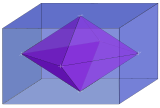Hyperrectangle
| Hyperrectangle Orthotope | |
|---|---|
 A rectangular cuboid is a 3-orthotope | |
| Type | Prism |
| Faces | 2n |
| Edges | n × 2n−1 |
| Vertices | 2n |
| Schläfli symbol | {}×{}×···×{} = {}n[1] |
| Coxeter diagram | |
| Symmetry group | [2n−1], order 2n |
| Dual polyhedron | Rectangular n-fusil |
| Properties | convex, zonohedron, isogonal |

In geometry, a hyperrectangle (also called a box, hyperbox, -cell or orthotope[2]), is the generalization of a rectangle (a plane figure) and the rectangular cuboid (a solid figure) to higher dimensions. A necessary and sufficient condition is that it is congruent to the Cartesian product of finite intervals.[3] This means that a -dimensional rectangular solid has each of its edges equal to one of the closed intervals used in the definition. Every -cell is compact.[4][5]
If all of the edges are equal length, it is a hypercube. A hyperrectangle is a special case of a parallelotope.
Formal definition
For every integer from to , let and be real numbers such that . The set of all points in whose coordinates satisfy the inequalities is a -cell.[6]
Intuition
A -cell of dimension is especially simple. For example, a 1-cell is simply the interval with . A 2-cell is the rectangle formed by the Cartesian product of two closed intervals, and a 3-cell is a rectangular solid.
The sides and edges of a -cell need not be equal in (Euclidean) length; although the unit cube (which has boundaries of equal Euclidean length) is a 3-cell, the set of all 3-cells with equal-length edges is a strict subset of the set of all 3-cells.
Types
A four-dimensional orthotope is likely a hypercuboid.[7]
The special case of an n-dimensional orthotope where all edges have equal length is the n-cube or hypercube.[2]
By analogy, the term "hyperrectangle" can refer to Cartesian products of orthogonal intervals of other kinds, such as ranges of keys in database theory or ranges of integers, rather than real numbers.[8]
Dual polytope
| n-fusil | |
|---|---|
 Example: 3-fusil | |
| Type | Prism |
| Faces | 2n |
| Vertices | 2n |
| Schläfli symbol | {}+{}+···+{} = n{}[1] |
| Coxeter diagram | |
| Symmetry group | [2n−1], order 2n |
| Dual polyhedron | n-orthotope |
| Properties | convex, isotopal |
The dual polytope of an n-orthotope has been variously called a rectangular n-orthoplex, rhombic n-fusil, or n-lozenge. It is constructed by 2n points located in the center of the orthotope rectangular faces.
An n-fusil's Schläfli symbol can be represented by a sum of n orthogonal line segments: { } + { } + ... + { } or n{ }.
A 1-fusil is a line segment. A 2-fusil is a rhombus. Its plane cross selections in all pairs of axes are rhombi.
| n | Example image |
|---|---|
| 1 | Line segment { } |
| 2 |  Rhombus { } + { } = 2{ } |
| 3 |  Rhombic 3-orthoplex inside 3-orthotope { } + { } + { } = 3{ } |
See also
Notes
- ^ a b N.W. Johnson: Geometries and Transformations, (2018) ISBN 978-1-107-10340-5 Chapter 11: Finite symmetry groups, 11.5 Spherical Coxeter groups, p.251
- ^ a b Coxeter, 1973
- ^ Foran (1991)
- ^ Rudin (1976:39)
- ^ Foran (1991:24)
- ^ Rudin (1976:31)
- ^ Hirotsu, Takashi (2022). "Normal-sized hypercuboids in a given hypercube". arXiv:2211.15342.
- ^ See e.g. Zhang, Yi; Munagala, Kamesh; Yang, Jun (2011), "Storing matrices on disk: Theory and practice revisited" (PDF), Proc. VLDB, 4 (11): 1075–1086, doi:10.14778/3402707.3402743.
References
- Coxeter, Harold Scott MacDonald (1973). Regular Polytopes (3rd ed.). New York: Dover. pp. 122–123. ISBN 0-486-61480-8.
External links
- Weisstein, Eric W. "Orthotope". MathWorld.
- Foran, James (1991-01-07). Fundamentals of Real Analysis. CRC Press. ISBN 9780824784539. Retrieved 23 May 2014.
- Rudin, Walter (1976). Principles of Mathematical Analysis. McGraw-Hill.













![{\displaystyle [a,b]}](https://wikimedia.org/api/rest_v1/media/math/render/svg/9c4b788fc5c637e26ee98b45f89a5c08c85f7935)

